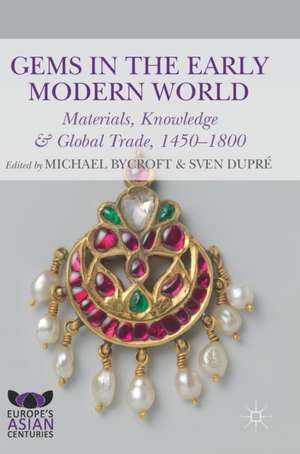Gems in the Early Modern World: Materials, Knowledge and Global Trade, 1450–1800: Europe's Asian Centuries
Editat de Michael Bycroft, Sven Dupréen Limba Engleză Hardback – 6 dec 2018
Preț: 902.06 lei
Preț vechi: 1100.06 lei
-18% Nou
Puncte Express: 1353
Preț estimativ în valută:
172.61€ • 184.58$ • 143.92£
172.61€ • 184.58$ • 143.92£
Carte tipărită la comandă
Livrare economică 17 aprilie-01 mai
Preluare comenzi: 021 569.72.76
Specificații
ISBN-13: 9783319963785
ISBN-10: 3319963783
Pagini: 337
Ilustrații: XVII, 359 p. 48 illus., 35 illus. in color.
Dimensiuni: 148 x 210 x 24 mm
Greutate: 0.76 kg
Ediția:1st ed. 2019
Editura: Springer International Publishing
Colecția Palgrave Macmillan
Seria Europe's Asian Centuries
Locul publicării:Cham, Switzerland
ISBN-10: 3319963783
Pagini: 337
Ilustrații: XVII, 359 p. 48 illus., 35 illus. in color.
Dimensiuni: 148 x 210 x 24 mm
Greutate: 0.76 kg
Ediția:1st ed. 2019
Editura: Springer International Publishing
Colecția Palgrave Macmillan
Seria Europe's Asian Centuries
Locul publicării:Cham, Switzerland
Cuprins
1. Introduction; Michael Bycroft and Sven Dupré.- Part I. Motion.- 2. The Plundering of the Ceylonese Royal Treasury, 1551-53: its Character, Cost and Dispersal; Hugo Miguel Crespo.- 3. Diamond-studded Paths: Lines of Communication and the Trading Network of the Hellemans Family, Jewellers from Antwerp; Christina M. Anderson.- 4. The Impact of European Trade with Southeast Asia on the Mineralogical Studies of Robert Boyle; Claire Sabel.- Part II. Value.- 5. Branches and Bones: The Transformative Matter of Coral in Ming Dynasty China; Anna Grasskamp.- 6. Boethius de Boodt and Emergence of the Oriental/Occidental Distinction in European Mineralogy; Michael Bycroft.- 7. Good and Bad Diamonds in Seventeenth-century Europe; Marcia Pointon.- 8. The Repudiation and Persistence of Lapidary Medicine in Eighteenth-century Dutch Medicine and Pharmacy; Marieke Hendriksen.- Part III. Skills.- 9. Polito et Claro. The Art and Knowledge of Polishing, 1200-1500; Marjolijn Bol.- 10. Mughal Lapidariesand the Inherited Modes of Production; Taylor L. Viens.- 11. Knowledge, Technique, and Taste in Transit: Diamond Polishing in Europe, 1500-1800; Karin Hofmeester.- 12. Gems and Counterfeited Gems in Early Modern Antwerp: from Workshops to Collections; Marlise Rijks.
Notă biografică
Michael Bycroft is Assistant Professor of the History of Science and Technology at the University of Warwick, UK. He completed his PhD in the History and Philosophy of Science at the University of Cambridge in 2013, and has since held fellowships at the Max Planck Institute for the History of Science and the University of Warwick. He specialises in the physical sciences in early modern Europe, and is writing a monograph on the role of precious stones in the scientific revolution.
Sven Dupré is Professor of History of Art, Science and Technology at Utrecht University and the University of Amsterdam, The Netherlands. He directs ARTECHNE, an interdisciplinary project on technique in the arts, supported by the European Research Council. Previously he was a Professor of History of Knowledge at the Freie Universität in Berlin.
Sven Dupré is Professor of History of Art, Science and Technology at Utrecht University and the University of Amsterdam, The Netherlands. He directs ARTECHNE, an interdisciplinary project on technique in the arts, supported by the European Research Council. Previously he was a Professor of History of Knowledge at the Freie Universität in Berlin.
Textul de pe ultima copertă
This edited collection is an interdisciplinary study of gems in the early modern world. It examines the relations between the art, science, and technology of gems, and it does so against the backdrop of an expanding global trade in gems. The eleven chapters are organised into three parts. The first part sets the scene by describing how gems moved around the early modern world, how they were set in motion, and how they were pulled together in the course of their travels. The second part is about value. It asks why people valued gems, how they determined the value of a given gem, and how the value of a gem was connected to its perceived place of origin. The third part deals with the skills involved in cutting, polishing, and mounting gems, and how these skills were transmitted and articulated by artisans. The common themes of all these chapters are materials, knowledge and global trade. The contributors to this volume focus on the material properties of gems such as their weight and hardness, on the knowledge involved in exchanging them and valuing them, and on the cultural consequences of the expanding trade in gems in Eurasia and the Americas.
Caracteristici
Explores the significance to commerce, industry, art, science and technology of gems in the early modern period Chapters cover a range of global trade routes connecting Europe, Asia and the Americas Contributes to emerging scholarship on the global history of materials




